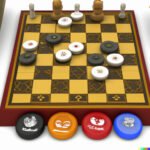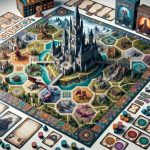Strategy board games have long been a favorite pastime for individuals looking to engage in strategic thinking and friendly competition. In this article, we will delve into the world of creating your very own strategy board game from scratch. From selecting a theme to designing the gameplay mechanics, we will guide you through the process step by step on how to make a strategy board game that will captivate players and stand out in the crowded board game market.
The appeal of strategy board games lies in their ability to challenge our cognitive skills, foster critical thinking, and provide hours of entertainment for players of all ages. Whether it’s devising clever tactics to outsmart opponents or carefully planning each move to reach victory, the satisfaction of crafting a winning strategy is what makes these games so popular among enthusiasts.
By understanding the fundamental principles behind creating a successful strategy board game, you can tap into this captivating world of tabletop gaming and unleash your creativity.
In this comprehensive guide, we will explore every aspect of developing a strategy board game – from conducting research on existing games to prototyping and playtesting your unique creation. With attention to detail on designing game components, crafting clear rules, and enhancing visual appeal through artwork and graphics, you’ll gain valuable insights on how to bring your vision to life.
So let’s embark on this exciting journey together as we uncover the secrets behind making a compelling strategy board game that will leave players coming back for more.
Understanding the Basics
Creating a strategy board game involves a combination of creativity, critical thinking, and attention to detail. One of the first steps in this process is understanding the basics of game creation, which includes theme selection and game mechanics. When brainstorming ideas for your strategy board game, consider themes that interest you and would appeal to your target audience. Whether it’s medieval warfare, space exploration, or political intrigue, choosing a theme that resonates with players can enhance their overall experience.
Once you have decided on a theme, you can begin developing the game mechanics that will drive the gameplay. Game mechanics are essentially the rules and interactions that govern how players engage with the game world. This includes elements such as player actions, resource management, and victory conditions. Careful consideration should be given to balancing these mechanics to ensure a challenging yet enjoyable experience for all players.
When designing the foundation of your strategy board game, remember to keep accessibility in mind. While depth and complexity are important in a strategy game, it’s crucial to strike a balance that allows new players to easily grasp the rules while offering enough strategic depth to keep experienced gamers engaged.
By focusing on theme selection and game mechanics early in the design process, you can create a solid foundation for your strategy board game that will captivate players and stand the test of time.
| Aspect | Importance |
|---|---|
| Theme Selection | Crucial for player engagement |
| Game Mechanics | Determines gameplay experience |
| Accessibility | Key for attracting new players |
Research and Inspiration
When embarking on the journey of creating a strategy board game, one of the crucial steps is researching existing games and drawing inspiration for your own creation. By familiarizing yourself with the landscape of strategy board games, you can gather valuable insights into what makes a successful game and learn from both the successes and failures of others in the industry.
This research phase serves as a foundation for your creative process and can help shape the direction of your game design.
One way to start your research is by playing a wide variety of strategy board games. This hands-on approach allows you to experience different mechanics, themes, and strategies firsthand, giving you a deeper understanding of what works well in a game and what could be improved upon.
Take note of elements that capture your interest or make gameplay engaging, as these can serve as inspirations for your own game design. Additionally, analyzing player feedback and reviews can provide valuable insights into common preferences and pain points within the genre.
Drawing inspiration from diverse sources outside of traditional board games can also fuel creativity in your design process. Look to other forms of media such as books, movies, or video games for thematic ideas or innovative mechanics that can be adapted to fit within a board game framework. By thinking outside the box and combining different influences creatively, you can bring fresh ideas to the table and make your strategy board game stand out in a competitive market.
Game Design
Creating a strategy board game involves a careful balance of elements that make the game engaging, challenging, and fun for players. When designing the game, it is essential to pay attention to various aspects such as the board layout, pieces used, rules established, and strategic elements incorporated. Here are some key steps on how to make strategy board game effectively:
1. Board Design: The layout of the game board plays a crucial role in determining the player’s experience. Consider factors such as the number of spaces, pathways, obstacles, and special zones that can influence gameplay. Sketch out different board designs to test how they impact player strategies and interactions during the game.
2. Pieces Selection: Choosing the right pieces for your strategy board game is essential for creating an immersive experience. Whether using tokens, figurines, or cards, ensure that each piece serves a specific purpose in gameplay. Differentiate pieces based on their functions, abilities, or values to provide players with strategic options and decision-making opportunities.
3. Rule Establishment: Developing clear and concise rules is vital for guiding players on how to play the game effectively. Outline turn sequences, victory conditions, movement rules, combat mechanics, and any special actions or abilities that players can utilize during gameplay. Test your rules thoroughly through playtesting to identify any potential loopholes or areas that require clarification.
By focusing on these aspects of game design when creating a strategy board game, you can craft an engaging and strategic experience that will captivate players and keep them coming back for more challenges and fun adventures on the tabletop. Remember to iterate on your design through prototyping and testing to refine your ideas and ensure that your game captures the essence of strategic decision-making and tactical planning in every session played with friends and family.
Prototyping and Testing
When it comes to creating a strategy board game, prototyping and testing play a crucial role in refining the game mechanics and ensuring a smooth gameplay experience for players. The first step in this process is to create a prototype of your game, which can range from a simple paper version to a more sophisticated digital representation.
A prototype helps you visualize how the game will work in real life and allows you to test out different mechanics before committing to the final design.
After creating a prototype, the next important step is playtesting. This involves gathering feedback from players who try out your game, whether they are friends, family members, or even strangers at gaming events. Playtesting helps identify any issues with the rules, balance of the game, or overall enjoyment factor. By observing how players interact with your game and listening to their feedback, you can make necessary adjustments to improve the gameplay experience.
It is essential to conduct multiple rounds of playtesting with different groups of people to gather diverse perspectives on your strategy board game. Iterating on your design based on feedback received during playtesting will help refine the mechanics, balance, and overall fun factor of the game. Remember that playtesting is an iterative process that may require multiple revisions before achieving a polished final product that delivers an engaging and rewarding experience for players.
| Strategy Board Game Creation Step | Description |
|---|---|
| Create Prototype | Develop a working model of your game to visualize mechanics. |
| Conduct Playtesting | Gather feedback from players to identify issues and improve gameplay. |
| Iterate Design | Make necessary revisions based on playtest feedback for refinement. |
Artwork and Graphics
Importance of Artwork in Strategy Board Games
Artwork plays a crucial role in the overall design and appeal of a strategy board game. It is essential to create visuals that not only attract players but also enhance the thematic elements of the game.
The artwork sets the tone for the entire gaming experience, immersing players in the world you have created. Whether it’s intricate illustrations on the board or detailed character designs on game pieces, investing time and effort into creating captivating artwork can elevate the overall gameplay.
Graphic Design for Clarity and Functionality
In addition to artwork, graphic design is equally important when it comes to creating a strategy board game. Clear and functional graphics are essential for conveying information to players effectively. Graphics are used to illustrate rules, provide visual cues for gameplay, and communicate essential details such as scoring systems or player turn order. Investing in good graphic design ensures that players can easily understand and engage with the game mechanics without feeling confused or overwhelmed.
Working With Artists and Designers
If you’re not artistically inclined yourself, don’t worry. Collaborating with talented artists and graphic designers can help bring your vision to life. Consider reaching out to professionals who specialize in board game art and graphic design to ensure that your game looks polished and professional.
Whether you hire freelancers or work with a design agency, communicating your vision clearly and providing detailed briefs will help them create artwork and graphics that align with your creative direction. Remember, striking visuals can make a significant difference in capturing the attention of potential players and making your strategy board game stand out in a crowded market.
Rulebook and Instructions
Creating a rulebook for your strategy board game is essential to ensure that players understand how to play the game effectively. A well-written and clear set of rules can enhance the overall gaming experience and prevent any confusion or disputes during gameplay. In this section, we will discuss the key components of crafting a rulebook that effectively guides players through your game.
Components of a Rulebook
When creating a rulebook for your strategy board game, it is important to include several key components to provide comprehensive guidance to players. These components may include an overview of the game, setup instructions, gameplay mechanics, detailed rules for each element of the game, examples or scenarios to illustrate gameplay, and frequently asked questions (FAQs) to address common concerns. Organizing these components in a logical and easy-to-follow format can help players navigate the rulebook efficiently.
Clarity and Conciseness
One of the most crucial aspects of writing a rulebook is ensuring that the rules are clear, concise, and easy to understand. Avoid using ambiguous language or overly technical terms that may confuse players. Instead, use simple language and provide examples or illustrations whenever necessary to clarify complex rules. Additionally, organizing the rules in a logical order and using bullet points or numbered lists can make it easier for players to reference specific rules during gameplay.
Formatting and Design
In addition to clear and concise writing, consider the formatting and design of your rulebook to enhance its usability. Use headings, subheadings, and bold text to highlight important information and differentiate sections within the rulebook.
Incorporating visuals such as diagrams, illustrations, or icons can also aid in clarifying rules or demonstrating specific actions in the game. Additionally, providing a table of contents or index at the beginning of the rulebook can help players quickly locate specific rules or topics while playing the game.
Marketing and Distribution
After putting in countless hours designing, playtesting, and perfecting your strategy board game, the next crucial step is marketing and distribution. This phase is essential to ensure that your game reaches its intended audience and garners the attention it deserves.
One effective strategy for promoting your board game is to utilize social media platforms to create buzz and generate interest among potential players. Sharing sneak peeks, behind-the-scenes insights, and engaging with your audience can help build anticipation for the official release of your game.
In addition to social media, tapping into board game communities both online and offline can be beneficial in spreading the word about your creation. Participating in forums, attending gaming conventions, or even hosting demo events can give you valuable exposure within the gaming community.
Collaborating with influencers or reviewers in the board game industry can also help increase visibility and credibility for your game. By sending out review copies or sponsoring gameplay videos, you can reach a wider audience through established channels.
When it comes to distribution, exploring different avenues such as partnering with retailers, utilizing crowdfunding platforms like Kickstarter, or even self-publishing can all be viable options based on your budget and goals. Working with distributors who specialize in board games can streamline the process of getting your game into stores or online platforms.
Additionally, creating a visually appealing website or online store where customers can purchase directly from you can also be an effective way to distribute your strategy board game. Remember that consistency in marketing efforts, maintaining good relationships with partners, and continuously seeking feedback from players are key components to successfully promoting and distributing your board game to a wider audience.
Conclusion
In conclusion, creating a strategy board game can be a fulfilling and rewarding experience for game enthusiasts and designers alike. By understanding the basics of theme selection, game mechanics, and drawing inspiration from existing games, you can embark on the exciting journey of designing your own unique board game. The process of design, prototyping, playtesting, and refining elements like artwork and graphics are crucial steps in ensuring that your game is not only enjoyable but visually appealing as well.
One key aspect that cannot be overlooked is the development of a clear and concise rulebook and instructions. Providing players with easy-to-understand rules will enhance their gameplay experience and prevent any confusion or misunderstandings during gameplay sessions.
Additionally, marketing and distribution strategies play a significant role in bringing your strategy board game to a wider audience. Utilizing social media platforms, attending gaming conventions, and seeking partnerships with retailers are effective ways to promote your game and increase its visibility in the market.
As you venture into the world of creating strategy board games, remember that each step of the process is an opportunity for growth and innovation. Embrace the challenges that come with designing a game from scratch, learn from feedback during playtesting sessions, and continuously seek ways to improve both the gameplay mechanics and visual elements of your creation.
With dedication, creativity, and perseverance, you have all the tools necessary to bring your vision to life – so why not start today on crafting your very own strategy board game?
Frequently Asked Questions
How Do You Make a Strategic Game?
Making a strategic game involves designing rules and mechanics that require players to think critically, plan ahead, and make tactical decisions. Balancing gameplay elements, providing meaningful choices, and creating challenging scenarios are key aspects of crafting a strategic game.
What Makes a Good Strategy Board Game?
A good strategy board game should offer depth and complexity to engage players, while still being accessible enough for new players to learn. Well-designed mechanics, balanced gameplay, player interaction, and replay value are important factors in making a strategy board game enjoyable.
How to Create Your Own Board Game?
Creating your own board game involves several steps, starting with brainstorming the concept and theme of the game. Designing the rules, mechanics, components, and game board come next, followed by playtesting and refining the game based on feedback.
It’s important to consider the target audience and ensure the game is both fun and engaging for players. Marketing strategies will also be necessary to promote the finished product successfully.

I love playing all kinds of games – from classics like Monopoly to modern favourites like Ticket to Ride.
I created this blog as a way to share my love of board games with others, and provide information on the latest releases and news in the industry.





